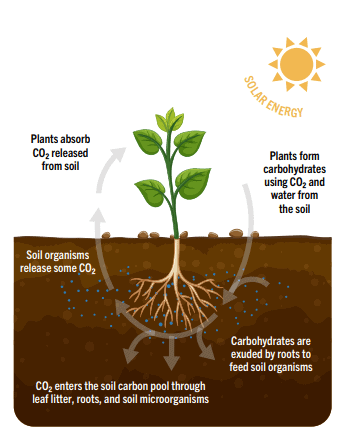You may have learned about the carbon cycle in school, but if you want a quick refresher, check out this resource. Sequestration is the part of the cycle in which plants store carbon atoms in their biomass and in the ground. Sequestration is a big buzzword lately. That’s because it’s super important! Think of activities that emit carbon – like burning fossil fuels, deforestation, and land degradation – as a faucet filling a giant bathtub (the atmosphere of our planet). Imagine the tub is overflowing and the bathroom is flooding. This is not great for your house, to say the least! So what do you do? You turn the faucet off. But what about all the water (or, carbon) that’s left over in your house? Sequestration is the mop, or the shop vac, to safely remove all that excess.
Carbon gardening is the practice of using techniques to increase the amount of CO2 that plants pull from the air and store or sequester in the soil.. When you build healthy soil, you’re sequestering carbon; it’s that simple. The Rodale Institute claims, “If we can increase the amount of carbon we have stored in our soils around the world by just 0.4% per year, we could absorb all of the excess carbon we currently emit.”
“Soil organic carbon is the primary component of soil organic matter and provides the basis for soil fertility. It helps retain & release nutrients for plant growth, promotes soil structure, biological & physical health, and increases the buffering capacity and resilience of soils against adverse climatic events. Soil organic carbon is part of the natural carbon cycle, with the world’s soils holding roughly twice as much carbon as is found in the atmosphere and vegetation.” – Fibershed

How to Grow Carbon at Home
- Compost – mix compost into your soil, and use as a top dressing to feed plants as needed
- Cover exposed soil with mulch or cover crops
- Plant natives – native species above ground play nicely with native soil organisms below. Go with local native plants to attract local pollinators and create habitat at the same time!
- Diversify your species – the more diverse things are above, the more diverse below!
- Plant perennials and cover crops to maximize continuous living roots – roots feed carbs to soil life, an essential step of the carbon cycle
- Minimize soil disturbances like tilling, which are harmful to soil ecology and thus release CO2
- Skip the synthetic fertilizers, pesticides and herbicides – these substances can harm microorganisms in the soil and emit climate disrupting gasses
- Know what you’re working with! Test your soil
Check out this super cool tool from our friends at Landscape Analytic Solutions, the Carbon Sequestration Calculator

